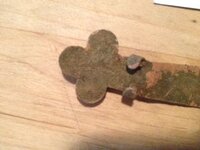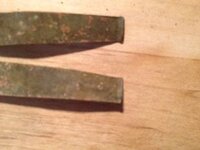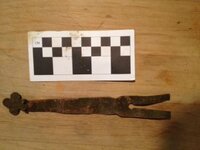Hi,
I am hoping someone can identify this item. I found it on a field in northeastern Massachusetts that was used in 1861 as a training field for the Danvers Light Infantry, a unit of the Mass. Volunteer Militia. A patch of exposed granite ledge nearby has engravings of the unit's insignia and the initials of several soldiers. The land has been farmland since the late seventeenth century. We also found a large buckle, presumably from horse tack, and a spent .38-40 cartridge casing.
The item is appears to be made of copper or copper alloy, and is approximately 1/8 inch thick and very malleable -- almost too thin to be furniture hardware. My guess, based on the tabs and the fixture on the forked end, is that it was some form of clasp that was affixed to leather or fabric.
Any info on the item's identification and age and origin would be greatly appreciated. Thanks
I am hoping someone can identify this item. I found it on a field in northeastern Massachusetts that was used in 1861 as a training field for the Danvers Light Infantry, a unit of the Mass. Volunteer Militia. A patch of exposed granite ledge nearby has engravings of the unit's insignia and the initials of several soldiers. The land has been farmland since the late seventeenth century. We also found a large buckle, presumably from horse tack, and a spent .38-40 cartridge casing.
The item is appears to be made of copper or copper alloy, and is approximately 1/8 inch thick and very malleable -- almost too thin to be furniture hardware. My guess, based on the tabs and the fixture on the forked end, is that it was some form of clasp that was affixed to leather or fabric.
Any info on the item's identification and age and origin would be greatly appreciated. Thanks








